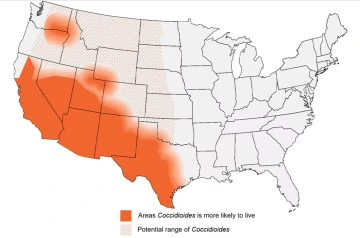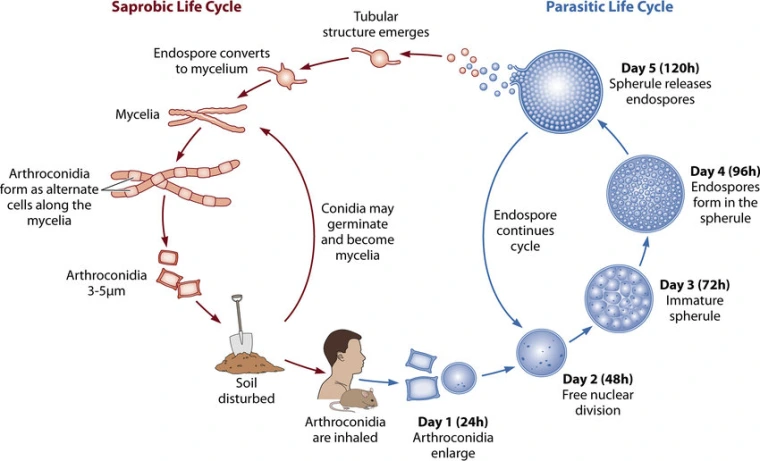Valley Fever is caused by a fungus that lives in the desert soil in the southwestern United States.

Like people, dogs are very susceptible to Valley fever. Dogs primarily contract Valley fever in the low desert regions of Arizona, New Mexico and southwestern Texas and the central deserts of California. Dogs accompanying people traveling through these areas or wintering in these warm climates have about the same chance as their owners of being infected.
Dogs comprise the majority of Valley Fever cases in animals.
However, other animals can get the disease as well. Cats, llamas, non-human primates, horses, zoo animals, and even wild animals have been reported with Valley Fever. More information on Valley Fever in other species.
Approximately 6-10% of dogs living in Pima, Pinal, and Maricopa counties in Arizona will become sick with Valley Fever each year.
The rate of illness in other Valley fever endemic locations is not known, but it is lower most places than central and southern Arizona.
Not all dogs who breathe in spores become sick.
About 70% of dogs who inhale Valley Fever spores control them quickly. These dogs are asymptomatic and are probably immune to the disease afterwards. This is very similar to what happens in people.
The life cycle of Coccidioides
As part of its life cycle, the fungus grows in the soil and dries into fragile strands of cells.
The strands are very delicate, and when the soil is disturbed - by digging, walking, construction, high winds - the strands break apart into tiny individual spores called arthroconidia or arthrospores. Dogs and other animals mainly acquire Valley Fever by inhaling these fungal spores in the dust and air. The dog may inhale only a few spores or many hundreds.
Once inhaled, the spores grow into spherules which continue to enlarge until they burst, releasing hundreds of endospores.
Each endospore can grow into a new spherule, spreading the infection in the lungs until the dog's immune system surrounds and destroys it. The sickness Valley Fever occurs when the immune system does not kill the spherules and endospores quickly and they continue to spread in the lungs and sometimes throughout the animal's body.

Prevention of Valley Fever in Dogs
Currently, there is no sure fire way to prevent Valley Fever in pets short of never residing in or traveling through the areas where the fungus grows. Valley Fever endemic areas are among the fastest growing regions in the country, which makes encounters of animals and people with the fungus a likely event.
Things you can do to reduce the likelihood of your dog's exposure to the fungus:
Avoid activities that generate dust, reduce digging behavior by dogs, prevent sniffing in rodent holes, and keep dogs indoors more than outdoors. Treating the soil is currently not practical as the fungus lives in spotty areas and can live up to 12 inches deep in the ground. Yard ground cover that reduces dust, however, is helpful: grass and deep gravel or other dust-controlling cover.
A vaccine is under development.
It is possible a vaccine will be available in the future to prevent Valley Fever or make it only a very mild illness in dogs. Vaccination against Valley Fever would be very useful for animals traveling to places like southern Arizona and southern California as well as for those dogs that live in these places.

